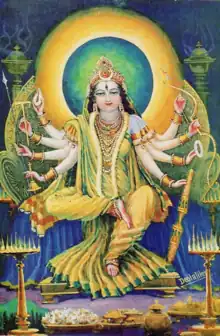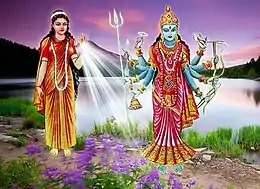Kaushiki
Kaushiki (Sanskrit: कौशिकी, romanized: Kauśikī, lit. 'woman of the cell',[1]) is a Hindu goddess, a deity who emerged from the sheath of Parvati.[2] She was created before Parvati's conflict with the asura brothers Shumbha and Nishumbha, and was also the reason the Matrikas come into existence. According to the Lakshmi Tantra, Kaushiki is a manifestation of the goddess Lakshmi.
| Kaushiki | |
|---|---|
 Kaushiki's form of Mahasaraswati | |
| Other names | Ambika, Mahasaraswati, Chandika |
| Affiliation | |
| Abode | Vindhya Parvata, Himalayas, Manidvipa, Vaikuntha |
| Mantra | Oṃ Kauśikyai Namaḥ |
| Weapon | Trishula, Bell, bow and arrow, Plough, Pestle, Conch, Discus |
| Mount | Lion |
| Texts | Markandeya Purana, Devi Bhagavata Purana, Lakshmi Tantra, Shiva Purana, Devi Mahatmya, Skanda Purana, Tripura Rahasya, Kalika Purana |
| Festivals | Navaratri |
Legends
Puranas
The story of Kaushiki is described in Devi Mahatmyam of Markandeya Purana. The Devi Mahatmyam describes that the goddess Kaushiki appeared from the sheath (or kosha) of the goddess Parvati’s body when the devas sang her praises after she defeated the asuras Shumbha and Nishumbha. Their eulogies that were intended to be a plea for help caused her to manifest from Parvati's form as a fair-skinned and bright being, earning the epithet 'Gauri'. The fact that she had been created from the cells of Parvati caused her to name herself Kaushiki, literally meaning 'woman of the cell'. With the fairness of her skin separated from her form, Parvati became dark-skinned and assumed the name of Kali. The deities went their separate ways, with Kaushiki departing to the Himalayas.[3] The minions of the asura brothers, Chanda and Munda, caught a glimpse of Kaushiki and rushed to urge Shumbha to claim her. With the help of the Matrikas, who were the female forms of the Trimurti, consisting of Brahmani, Vaishnavi, and Maheshwari, along with Varahi, Narasimhi, and Shakti, and her other half, the goddess Chamunda (Kali), Kaushiki and her forces fought the asuras in a pitched battle in order to vanquish them and restore the natural order.[4] Following this, Parvati performed a penance in the Himalayas to restore her shakti and complexion before reuniting with Shiva.
Shiva Purana associates Kaushiki with Ugratara . It mentions that Kaushiki is also called as Matangi because of her source i.e. Parvati.
She alone is said to be Ugratārikā and great Ugratārikā. She is called Mātaṅgī after the source from which she manifested herself.
— Shiva Purana Uma Samhita Chapter 47, verse 15
Kalika Purana describes Kaushiki as the shakti that was born from the body of Goddess Matangi.
Devi Bhagavata Purana describes Kaushiki as the Shakti that came out from the body of Goddess Parvati, and she is called ‘Kaushiki’ in the beginning of Devi Bhagavata Purana.[5] [6][7][8][9]
O King! When the tormented Devas praised thus, the Devi created from Her body another supremely beautiful form. This created form, the Ambika Devi, became known in all the worlds as Kaushiki, as She came out of the physical sheath of the Devi Parvati.
— Srimad Devi Bhagavatam Fifth Canto, Chapter 23, Verses 1:2

Pancharatra Agamas
In Lakshmi Tantra, Lakshmi Devi tells Indra that she is the shakti who came out of Gauri as Kaushiki and killed many demons, including Shumbha and Nishumbha.
O Sakra, during the period of Tamasa (Manu),
I, the supreme Mahavidya, was Kaushiki, who sprang from the body of Gauri
to slay all those notorious demons including Shumbha and Nishumbha.
Thereby I rescued the worlds and helped the gods.
O lord of all gods, when worshipped with devotion.
I, the goddess Kaushiki fulfiller of many desires, bestow omniscience (on the devotee).– Lakshmi Tantra, Pancharatra Agama[10]
See also
References
- Bhattacharji, Sukumari; Sukumari (1998). Legends of Devi. Orient Blackswan. ISBN 978-81-250-1438-6.
- Mitter, Sara S. (1991). Dharma's Daughters: Contemporary Indian Women and Hindu Culture. Rutgers University Press. p. 78. ISBN 978-0-8135-1678-3.
- Bhattacharji, Sukumari; Sukumari (1998). Legends of Devi. Orient Blackswan. p. 29. ISBN 978-81-250-1438-6.
- Bhattacharji, Sukumari; Sukumari (1998). Legends of Devi. Orient Blackswan. pp. 31–35. ISBN 978-81-250-1438-6.
- Wangu, Madhu Bazaz (2003). Images of Indian goddesses : myths, meanings and models. New Delhi: Abhinav Publications. p. 185. ISBN 81-7017-416-3.
- Jones, Constance A.; Ryan, James D. (2007). "Virashaivas". Encyclopedia of Hinduism. New York, NY: Facts On File. p. 489. ISBN 978-0-8160-5458-9.
- Sinha, A. K. (2009). Approaches to history, culture, art and archaeology. New Delhi: Anamika Publishers. p. 500. ISBN 9788179752487.
- Mitter, Sara S. (1991). Dharma's daughters : contemporary Indian women and Hindu culture (2. print. ed.). New Brunswick, N.J.: Rutgers University Press. p. 78. ISBN 0-8135-1677-3.
- Kinsley, David (1 December 1975). "Freedom from Death in the Worship of Kali". Numen. 22 (3): 183–207. doi:10.2307/3269544. JSTOR 3269544.
- Sanjukta Gupta (2000). Laksmi Tantra: A Pancharatra Text. Motilal Banarsidass Publishers. p. 50. ISBN 9788120817357.